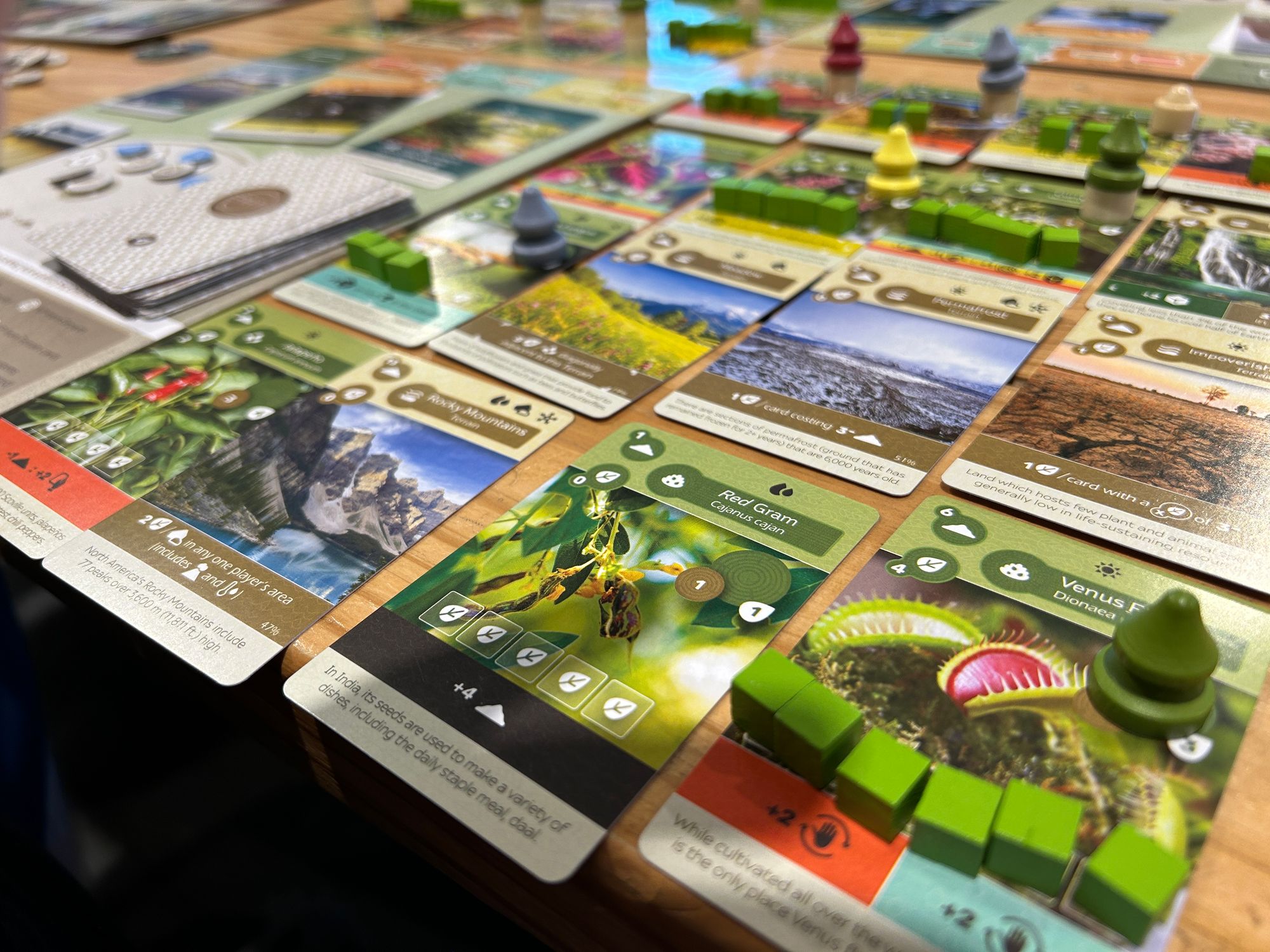Want something with a little more engine building than Wingspan but not nearly the time requirement of Terraforming Mars? Earth has you covered. It’s a deep engine builder with lead-and-follow Actions, great table presence, and hundreds of amazing nature photos adorning hundreds of unique cards. Sound interesting? Let’s dive in.
To start, place a common goal board between all players along with accessible piles of Dirt (cardboard chits), Sprouts (green cubes), and Tree components (trunk and canopy segments). Place four Fauna cards on the board along with two Ecosystem cards. Give each player a player board, five Leaves in their player color, two Island cards, two Climate cards, and two Ecosystem cards (players choose one of each of these to place on their board). Shuffle all the Earth cards and place them in piles accessible to players.
Players then draw a few cards, Compost some of them, and collect Dirt — all based on what their Island card indicates. Island and Climate cards are likely to have some kind of bonus Action unique to that player. A player’s Ecosystem card will give them an individual method of earning bonus points at the end of the game (but more on that in a bit). As you play, you’ll be creating a 4x4 Tableau of Earth cards that will make up your engine and earn most of your victory points.
Play begins by the active player selecting one of four colored Actions and then performing it. The Actions are:
- Play up to two Earth cards from your hand into your Tableau, then draw four Earth cards and keep one of them
- Collect five Dirt and Compost two cards from the Earth deck
- Plant six Sprouts and collect two Dirt
- Draw four cards and grow two Trees on your Tableau
When the active player selects and carries out an Action, all other players play a weaker form of that Action, so there isn’t a bunch of downtime between turns. Here’s where the engine building comes in: cards on your player board and in your Tableau often have abilities that match the color of the active player’s chosen Action. After the Action is performed, all cards a player has that have an ability that matches that color may trigger that ability.
Most of the cards in the Earth deck are Flora. These have spaces for growing Sprouts and Trees, and often have one or more colored ability. In addition to Flora cards, the Earth deck has Terrain cards and Event cards. Terrain cards are played into a player’s Tableau like Flora cards, but grant either an additional scoring condition or some kind of ongoing ability. Event cards aren’t played into a player’s Tableau (each player has their own discard pile for Events they play during the game) and grant some kind of immediate benefit. Event cards can be played at any time, even during another player’s turn.
Once a player has filled their 4x4 Tableau, play continues until all players have had an equal number of turns. Once this happens, players score up their player area, and whoever has the most points wins.
The components for Earth are pretty great considering the MSRP. Cards are sturdy and glossy, chits are decent chipboard, wooden cubes are standard stock, and the Tree segments are easy to stack up and don’t easily topple. Player boards are also sturdy chipboard that don’t pick up any warp after a handful of plays. The one thing that would be helpful is neoprene (or similar) mats to build our Tableaus on, but this isn’t necessary. In addition to the standard game, the game has a basic variant for new players, as well as a solo mode and a 2 vs. 2 team version of the game.
Earth has been a hit with each group I’ve played it with. It really adds more complexity to what Wingspan brings in terms of building and executing an Action, and the simultaneous lead-and-follow Actions really helps to keep players engaged. The asymmetric setup for players really helps to give an initial direction as to how to best design their engines (similar to how Preludes speeds up and gives more direction in the initial gameplay of Terraforming Mars). All-in-all, Earth is a fantastic medium-weight engine builder with an incredibly family-friendly theme that has very limited opportunity for direct player conflict. It plays up to five out of the box. It’s a great game to pick up if you can get your hands on it.
Designed by: Maxime Tardif
Player Count: 1-5
Playtime: 45-90 minutes
Time to Learn: 15 minutes
Complexity: 3.5/5
Replayability: 5/5
MSRP: $50
Written by Brendan Quinn, President of Tri-City Area Gaming. We’re out in the world again! Come play games with us at any of our regular monthly events.
All the links for Tri-City Area Gaming: tcag.carrd.co


